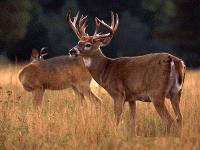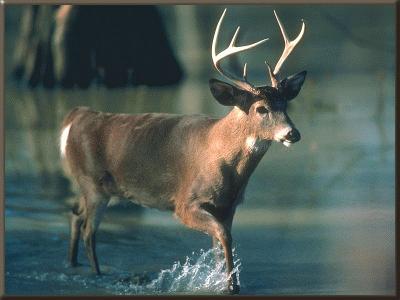
The White-Tailed Deer has acquired its name from the factthat the underside of the tail is white. These deer are classifiedas ruminant animals which means that they have a four-chambered stomach andthey often chew "cud".
Male deer are called bucks, females are referred to as does, and youngdeer are fawns.

Deer are the only animals with antlers.Antlers are actually bones. Male Cervids grow and shed a set of antlers each year. When antlers are growing,they are soft and subject to injury. The growth of the antlers isinfluenced by the pituitary gland. Yearling bucks that comefrom areas of poor food supply, may only grow "spikes". Spikes are antlers withonly one beam.
The average adult buck weighs 140 pounds, stands approximately 34 inches high, and is about 70 inches long from his nose to the base of his tail. His tail vertebrae add only about 11 inches. It should be noted that deer weights vary. A buck weighing 140 pounds in December might have weighed 180 pounds inSeptember.

Deer have hooves at the bottoms of their legs. Whitetails have scent producing glands.Two of these glands are located at two tarsals, one inside each hind leg near the hock joint; two other glands are located at two metatarsals, one outside each hind leg between the hock joint and the foot; and four glands located at the interdigitals, one between the toes of each foot. The glands in the tarsal and metatarsalareas release scents conveying excitement or fear, while the interdigital glands produceodors which allow deer to trail each other by smell.
White-Tailed Deer have great speed and leaping ability. Deer can reach speedsof 40 miles per hour for short periods of time and canmaintain a speed of 25 miles per hour for longer durations. White-TailedDeer can jump up to 9 feet high or 25 feet in length.
White-Tailed Deer are mostly matriarchal. This can be witnessedby fawns remaining with an adult doe for long periods of time.Siblings remain together through the summer.
The White-Tailed Deer's habitat is a typical brush-stage forestwhich provides a hiding place for the deer and an abundance of vegetation forfood. Deer are herbivores. They eat all types of plants.
The mating season for White-Tailed Deer begins in September and lastsuntil late January. Female fawns mate as young as 7 or 8 months produce thierfirst offspring at 14 to 15 months of age.